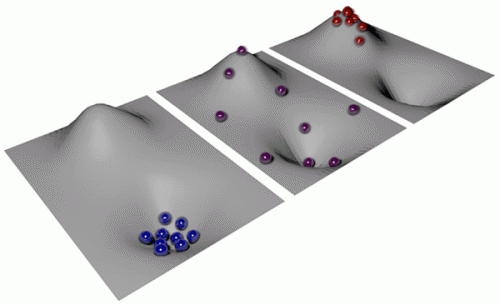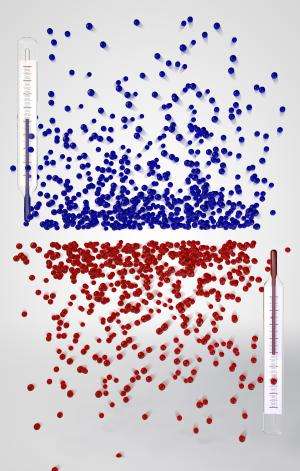Atoms at negative absolute temperature: The hottest systems in the world

(Phys.org)—In cold regions on earth, negative temperatures on the Fahrenheit or Celsius scale can often occur in winter; in physics, however, they were so far impossible. On the absolute temperature scale that is used by physicists and also called Kelvin scale, one cannot go below zero – at least not in the sense of getting colder than zero Kelvin. According to the physical meaning of temperature, the temperature of a gas is determined by the chaotic movement of its particles – the colder the gas, the slower the particles. At zero Kelvin (-460°F or -273°C) the particles stop moving and all disorder disappears. Thus, nothing can be colder than absolute zero on the Kelvin scale. Physicists of the Ludwig-Maximilians University Munich and the Max Planck Institute of Quantum Optics in Garching have now created an atomic gas in the lab that has nonetheless negative Kelvin values (Science, Jan 4, 2013).
These negative absolute temperatures lead to several striking consequences: Although the atoms in the gas attract each other and give rise to a negative pressure, the gas does not collapse – a behavior that is also postulated for dark energy in cosmology. Also supposedly impossible heat engines can be realized with the help of negative absolute temperatures, such as an engine with a thermodynamic efficiency above 100%.
In order to bring water to the boil, energy needs to be added to the water. During heating up, the water molecules increase their kinetic energy over time and move faster on average. Yet, the individual molecules possess different kinetic energies – from very slow to very fast. In thermal equilibrium, low-energy states are more likely than high-energy states, i.e. only a few particles move really fast. In physics, this distribution is called Boltzmann distribution. Physicists around Ulrich Schneider and Immanuel Bloch have now realized a gas in which this distribution is exactly inverted: Many particles possess large energies and only a few have small energies. This inversion of the energy distribution means that the particles have assumed a negative absolute temperature.
"The inverted Boltzmann distribution is the hallmark of negative absolute temperature; and this is what we have achieved," says Ulrich Schneider. "Yet the gas is not colder than zero Kelvin, but hotter. It is even hotter than at any positive temperature – the temperature scale simply does not end at infinity, but jumps to negative values instead." The underlying principle can best be visualized with an illustration (see Fig. 1): If one starts at positive temperatures (left figure) and increases the total energy of the balls by heating them up, the balls will also spread into regions of high energy. If one heated the balls to infinite temperature (central figure), each point in the landscape would be equally probable, irrespective of its energy. If one could add even more energy and thereby heat the balls even further, the balls would preferably gather at high-energy states (right figure) and would be even hotter than at infinite temperature. The Boltzmann distribution would be inverted, and the temperature therefore negative. At first sight it may sound strange that a negative absolute temperature is hotter than a positive one. This is, however, simply a consequence of the historic definition of absolute temperature; if it were defined differently, this apparent contradiction would not exist.

This inversion of the population of energy states is not possible in water or any other natural system with moving particles, as the system would need to absorb an infinite amount of energy – an impossible feat! However, if the system possesses an upper bound for the energy of the individual particles, such as the top of the hill for the potential energy in Fig. 1, the situation will be completely different. The researchers around Immanuel Bloch and Ulrich Schneider have now realized a gas of atoms possessing such an upper energy limit in their laboratory, following theoretical proposals by Allard Mosk and Achim Rosch.
In their experiment, the scientists first cool around a hundred thousand atoms in a vacuum chamber to a positive temperature of a few billionth Kelvin and capture them in optical traps made of laser beams. The surrounding ultrahigh vacuum guarantees that the atoms are perfectly isolated from the environment. The laser beams create a so-called optical lattice, in which the atoms are trapped in a perfectly ordered array of millions of bright light spots emerging from the interference between the laser beams. In this lattice, the atoms can still move from site to site via tunneling, yet their kinetic energy is limited from above and therefore possesses the required upper energy bound. Temperature, however, relates not only to kinetic energy, but the total energy of the particles, which in this case includes interaction and potential energy. The system of the Munich and Garching researchers also sets a limit to both of these. By suddenly turning a valley into a hill (and changing the interaction), the physicists then take the atoms to the upper boundary of the total energy – thus realizing a negative temperature, at minus a few billionth Kelvin.
"If balls possess a positive temperature and lie in a valley at minimum potential energy, this state will apparently be stable – this is nature as we know it. If the balls are located on top of a hill at maximum potential energy, they will usually roll down and thereby convert their potential energy into kinetic energy. If the balls are, however, at negative temperature, their kinetic energy will already be so large that it cannot increase further. Therefore the balls cannot roll down and stay on top of the hill. The energy boundary therefore renders the system stable!" explains Simon Braun, PhD student in the group. The negative temperature state in their experiment is indeed just as stable as a positive temperature state. "That way, we have created the first negative absolute temperature state for moving particles," he adds.
Matter at negative absolute temperature leads to a whole bunch of astounding consequences: With its help, one could create heat engines with an efficiency above 100%. This does not mean that the law of energy conservation is violated. Instead, the machine could not only absorb energy from the hotter substance, but, in contrast to the usual case, also from the colder. The work performed by the engine could therefore be larger than the energy taken from the hotter substance alone.
The achievement of the Munich physicists could additionally be interesting for cosmology. Concerning its thermodynamic behavior, negative temperature states exhibit parallels to the so-called dark energy. Cosmologists postulate dark energy as the elusive force that accelerates the expansion of the universe, although the cosmos should in fact contract because of the gravitational attraction between all masses. There is a similar phenomenon in the atomic cloud in the Munich lab: The experiment relies upon the fact that the atoms in the gas do not repel each other as in a usual gas, but instead interact attractively. This means that the atoms exert a negative instead of a positive pressure. As a consequence, the atom cloud wants to contract and should usually collapse – just as is expected for the universe under the influence of gravity. But because of its negative temperature this does not happen. The gas is saved from collapse just like the universe.
More information: Braun, S. et al., Atoms at negative absolute temperature - the hottest systems in the world, Science, 4 January 2013. www.sciencemag.org/content/339/6115/52
Journal information: Science
Provided by Max Planck Society



















